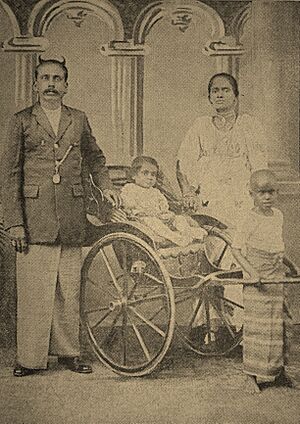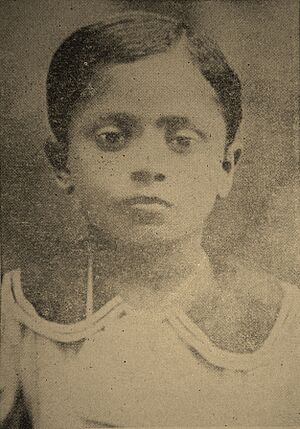Ranasinghe Premadasa facts for kids
Quick facts for kids
His Excellency Sri Lankabhimanya
Ranasinghe Premadasa
|
|
|---|---|
 |
|
| 3rd President of Sri Lanka | |
| In office 2 January 1989 – 1 May 1993 |
|
| Prime Minister | Dingiri Banda Wijetunga |
| Preceded by | Junius Richard Jayewardene |
| Succeeded by | Dingiri Banda Wijetunga |
| 8th Prime Minister of Sri Lanka | |
| In office 6 February 1978 – 2 January 1989 |
|
| President | Junius Richard Jayewardene |
| Preceded by | Junius Richard Jayewardene |
| Succeeded by | Dingiri Banda Wijetunga |
| Member of Parliament for Colombo Central |
|
| In office 22 March 1965 – 2 January 1989 |
|
| Preceded by | Razik Fareed |
| Succeeded by | constituency abolished |
| In office 19 March 1960 – 20 July 1960 |
|
| Preceded by | M. S. Themis |
| Succeeded by | Razik Fareed |
| Personal details | |
| Born | 23 June 1924 Colombo, British Ceylon (now in Sri Lanka) |
| Died | 1 May 1993 (aged 68) Colombo, Sri Lanka |
| Political party | United National Party |
| Spouses | Hema Premadasa (née Wickrematunge) |
| Children | Sajith, Dulanjali |
| Residence | Sucharitha |
| Alma mater | St Joseph's College, Colombo |
| Signature |  |
Sri Lankabhimanya Ranasinghe Premadasa (Sinhala: රණසිංහ ප්රේමදාස Raṇasiṃha Premadāsa,Tamil: ரணசிங்க பிரேமதாசா Raṇaciṅka Pirēmatācā; 23 June 1924 – 1 May 1993) was an important leader in Sri Lanka. He served as the third President of Sri Lanka from 1989 to 1993. Before becoming president, he was the prime minister under President J. R. Jayewardene from 1978 to 1989. In 1986, he received the Sri Lankabhimanya award, which is the highest honor for a civilian in Sri Lanka. He was the first person in Sri Lankan history to receive this award.
Contents
Early Life and Education
Ranasinghe Premadasa was born on June 23, 1924, in Colombo, which was then part of British Ceylon. He was the oldest of five children. His father worked in the transport business.
He went to school at Purwarama temple and later at Lorenz College and Saint Joseph's College, Colombo. When he was 15, Premadasa started the Sucharita Children's Society. This group aimed to help people in low-income areas improve their lives. He worked full-time as an organizer for community development projects starting in 1939.
Starting His Political Journey
Joining the Labour Party
In 1946, Premadasa began his political career by joining the Ceylon Labour Party. He worked hard to support the party's founder, A. E. Goonesinghe. In 1950, he was elected to the Colombo Municipal Council, which is like a local city government.
Moving to the United National Party
In the mid-1950s, Premadasa joined the United National Party (UNP). He became a Member of Parliament (MP) for Colombo Central in 1960. He focused on helping his community. He opened pre-schools for poor families and started training centers for young people to learn skills like sewing.
Becoming a Minister
In 1965, Premadasa was re-elected to parliament. He was then appointed as the Parliamentary Secretary to the Minister of Local Government. In 1968, he became the Minister of Local Government. During this time, he started projects to build bridges and housing schemes, like the Maligawatta Housing Scheme. He also helped turn Radio Ceylon, a famous radio station, into a public corporation called the Ceylon Broadcasting Corporation in 1967.
In Opposition and Back to Power
After the 1970 general election, Premadasa became a Member of Parliament for Colombo Central again. He served as the Chief Opposition Whip, helping to lead the opposition party. He also played a role in drafting the 1972 constitution for Sri Lanka.
Later, he became the Deputy Leader of the United National Party. In the 1977 general election, he was re-elected and became the Leader of the House and the Minister of Local Government, Housing and Construction.
Becoming Prime Minister
In 1978, when J. R. Jayewardene became the first Executive President, he appointed Premadasa as the Prime Minister. This was a new and important role. Premadasa started living at Temple Trees, the official residence for the Prime Minister.
As Prime Minister, he represented Sri Lanka on the world stage. He led the Sri Lankan team to the Commonwealth Heads of Government Meeting in 1979, where he helped secure funding for the Victoria Dam. He also spoke at the United Nations General Assembly in 1980.
He continued his work on housing, launching a program called "shelter for the poor." He even proposed that 1987 be declared the International Year of Shelter for the Homeless by the United Nations, which was accepted. Other programs he started included Jana Saviya to help the poor, the Gam Udawa project to develop villages, and the garment industry project, which created many jobs and brought in foreign money. He served as Prime Minister for ten years, until 1988.
Presidency
In December 1988, Ranasinghe Premadasa was elected the second executive president of Sri Lanka. He won with 50.43% of the votes. He was the first president who was not from the Govigama caste, which was a significant change in Sri Lankan politics.
When he became president, Sri Lanka was facing two major challenges: a civil war in the north and a communist uprising in the south. Premadasa focused on dealing with both of these issues.
Economic Plans
President Premadasa worked hard to improve the economy at the local level. He focused on providing housing, reducing poverty, and helping poor people. He encouraged the building of "model villages" that had clean water, good transport, schools, and health centers. He also supported small-scale industries, especially garment factories, in poor areas. He gave factory owners low-interest loans to help them start their businesses. His Gam Udāwa program and Janasaviya program (now called Samurdhi) are well-known achievements in this area.
Ending the Uprising
He appointed Ranjan Wijeratne as Minister of Defence. Wijeratne worked to stop the JVP uprising in the south of the island. This uprising had caused a lot of problems since 1987. An operation called "Operation Combine" successfully ended the uprising by early 1990.
Civil War Challenges
His handling of the civil war in the north was more difficult. The Liberation Tigers of Tamil Eelam (LTTE) were fighting against the Indian Peace-Keeping Force (IPKF). Many people in Sri Lanka did not like the Indian presence, so Premadasa asked India to remove its troops. The IPKF left in 1990, but the war with the LTTE continued.
Political Challenges
In September 1991, Premadasa faced an attempt to remove him from office by some rivals in his own party. He managed to defeat this attempt. He then removed these rivals from the party.
Assassination
Ranasinghe Premadasa was killed on May 1, 1993, during a May Day rally in Colombo. He died as a result of a bomb blast. His state funeral was held at Independence Square in Colombo on May 9, 1993.
Personal Life
Ranasinghe Premadasa married Hema Wickramatunge on June 23, 1964. They had a son named Sajith and a daughter named Dulanjali. Premadasa was known for being a very hard worker. He often woke up early and followed a strict daily routine. Even as Prime Minister and President, he preferred to live and work from his private home and office, called Sucharitha.
See also
 In Spanish: Ranasinghe Premadasa para niños
In Spanish: Ranasinghe Premadasa para niños
- Sajith Premadasa
- List of political families in Sri Lanka





